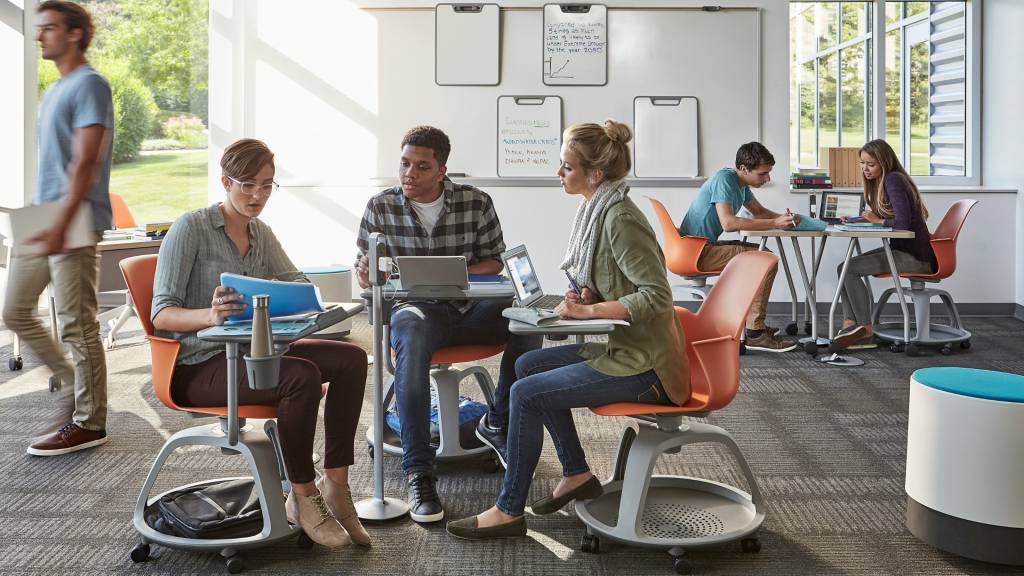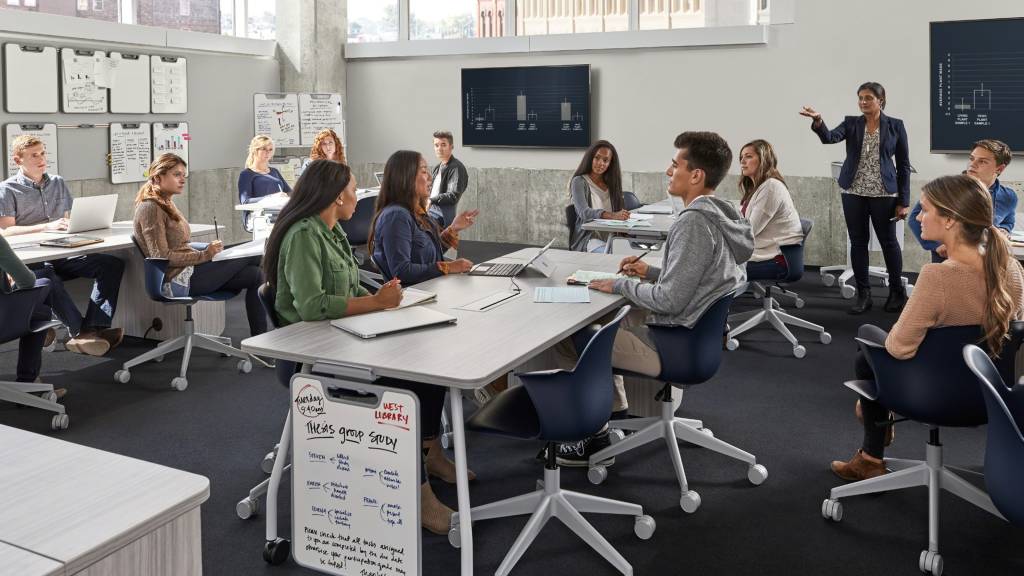Lessons Learned
Professor Robert Talbert, PhD, talks to 360 about his research on the effectiveness of active learning classrooms.
“Active learning puts students in charge. They’re responsible for how they understand the material,” says Robert Talbert, PhD, professor and assistant chair for the department of mathematics at Grand Valley State University. “An active learning classroom is any physical environment that facilitates this process, that lets students work in their own way to construct their own understanding of the material that’s being learned.”
To gain a better understanding around the effectiveness of these spaces, Talbert co-authored, “A Space for Learning,” a paper on his in-depth review of research on active learning spaces. Working with Anat Mor-Avi, a PhD student in the School of Architecture at the University of Illinois Institute of Tech, they looked at studies from 32 higher education classrooms and five primary and secondary ed classrooms to learn about the impact of active learning classrooms. Going as far back as 20 years, the peer-reviewed, controlled studies they reviewed provided a mix of qualitative and quantitative results on the effectiveness of active learning classrooms.
To discuss his research, 360 sat down with Talbert, who recently took a sabbatical at Steelcase Education as scholar-in-residence.
ACTIVE LEARNING CLASSROOM RESEARCH
A review of published research on active learning classrooms investigates their impact.
360: A lot of educators spend their careers focused on what they’re teaching. You’ve spent a lot of time focused on how you’re teaching. Why?
Robert Talbert: Education is not a transfer of information. It’s a human interaction. You can take the same material and put it in front of two completely different people and get two completely different responses. So, you should focus on what you’re teaching, but there has to be a human interaction to get inside the heads of the students to see how they’re going to make sense of it.

360: As someone who’s spent two decades looking through a different lens of how students learn, you’ve done extensive research on active learning. How do you describe active learning?
RT: Active learning is getting the construction of understanding back into the hands of the students and putting them in charge. The instructor is just there to construct the environment, manage the traffic, and make sure students are doing what they need to be doing to understand the material.
360: What does an active learning environment look like?
RT: Active learning classrooms can look like a lot of different things, but the ones where we see the best results for student learning and engagement really allow students to do whatever they need to learn. That could be physical movement or quiet space or isolation. Information needs to be able to flow from one student to the next, from the instructor to the students and from students to the whiteboard and being able to capture it or modify it at will in whatever way, again, that makes sense for the student.
360: What themes emerged in your research?

RT: We looked at four main research questions. How do active learning classrooms impact quantitative measures of student learning, such as test scores and so on? Secondly, beyond quantitative measures, how do active learning classrooms affect student engagement? What does it mean for a student to be engaged? We came to a certain notion about motivation as a proxy for engagement. We looked at any study where students’ motivations for studying something were in the forefront. We also went beyond students to think about how do active learning classrooms affect the instructors? Finally, what specific elements of active learning classrooms seem to make the most difference?
360: You found a study from the University of Minnesota where they experimented with two classroom styles — a traditional lecture hall and an active learning classroom. What did they discover?
RT: It was a 350-student chemistry class that met three times a week in a large lecture hall. They decided to build an active learning classroom with 13 groups of classroom tables with nine students each, to get small group interaction going. They split the class up into three cohorts of approximately 100 to 115 students each and they only met each cohort once a week. The other class meetings were replaced by intentional, highly-structured online activities.
There was a control and an experimental group. The group that met only once per week in person in the active learning classroom as well as learned online, far outperformed the traditional lecture class that met in person three times a week on all measures.
360: What did you uncover about the impact active learning classrooms have on instructors?
RT: In another study we reviewed, Chris Brooks, who was at the University of Minnesota, told a group of professors, “We’re going to put you in this active learning classroom, but don’t change anything about what you do.” But, it turned out as they observed the professors, they did change their teaching even though they were told not to. The professors weren’t even really aware of what they were doing. It’s like the room was exerting this evolutionary pressure, and they were lecturing less. They were getting into discussion more, much less so than they did in their old-fashioned, traditional classroom.
In the end, one of the unexpected findings of that was that even if you are consciously trying to restrain yourself from implementing active learning, it’s going to be hard to do when you’re in one of these classrooms.

360: You also looked at a study that controlled all sorts of variables in order to measure student motivation. Tell us what you found there.
RT: Wes Imms and Terry Byers, two Australian researchers, have a research methodology called single subject design, where there are no control and experimental groups. Everything stays constant except the space.
They’ll put a cohort of students through an educational experience for six weeks, and then pick the whole class up and move them to an active learning classroom for six weeks, then move them back into the traditional space for another six weeks.
What you see in this study is a certain baseline level of motivation in the traditional classroom. When they moved students into the active learning classroom, it spikes. It goes way up. Their attitude went from, “I’m sort of into being here,” to, “Yeah, I really like this.”
360: Looking at learning outcomes, student engagement, instructor practices, and this evolution of a new culture of learning, what do you want people to understand from the research synthesis you did?
RT: It really boils down to human interactions. That’s what teaching is. The interaction between teacher and student and between students and students. Any aspect of an active learning classroom that makes human connections easier is going to produce outsized results. For example, there was a really early study done where they refitted an existing traditional classroom by ripping out all the chairs and installing new collaborative seating that were bolted to the floor, but could swivel 360 degrees so students could turn around to talk to their neighbors. They had great results just allowing students to talk to each other. Things that allow that information flow, that person-to-person flow, to take place easier tend to get the best results.
ACTIVE LEARNING CLASSROOM RESEARCH
A review of published research on active learning classrooms investigates their impact.
 Robert Talbert, PhD, is a professor and assistant chair for the department of mathematics at Grand Valley State University (GVSU). With 21 years of teaching experience, Talbert was on the faculty at Franklin College and Bethel College prior to GVSU. Talbert holds a B.S. Degree from Tennessee Technological University, and M.S. and PhD Degrees from Vanderbilt University, all in mathematics.
Robert Talbert, PhD, is a professor and assistant chair for the department of mathematics at Grand Valley State University (GVSU). With 21 years of teaching experience, Talbert was on the faculty at Franklin College and Bethel College prior to GVSU. Talbert holds a B.S. Degree from Tennessee Technological University, and M.S. and PhD Degrees from Vanderbilt University, all in mathematics.
